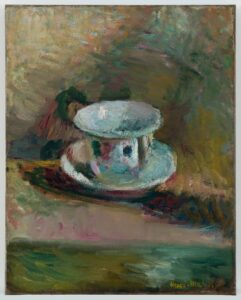Along with Pablo Picasso, Henri Matisse was one of the pillars of the Parisian avant-garde, whose formal innovations in painting would dominate much of modern art. Matisse initially worked in law, but discovered a passion for art when he began painting as an amateur. He went on to study traditional academic painting. In the early years of the twentieth century, however, he rejected the idea that painting had to imitate the appearance of nature. His characteristic innovations were the use of vibrant, arbitrary colors; bold, autonomous brushstrokes; and a flattening of spatial depth. This anti-naturalistic style inspired the critical name "fauves," or "wild beasts," for the group of painters around Matisse.
Ironically, Matisse often applied his thoroughly modern style to traditional subjects such as still lifes, landscapes, and portraits. Such works express a sense of timeless joy and stillness that runs counter to the frenetic, technologically inspired compositions of many of his contemporaries. Although primarily dedicated to painting, Matisse was also active as a sculptor and printmaker. In the 1940s, in failing health, he embarked on a well-known group of cut-paper collages.
 Henri MatisseStudy of Sarah Stein1916
Henri MatisseStudy of Sarah Stein1916 Henri MatisseGrosse tête; Henriette, II (Large Head; Henriette, II)1927, cast 1929
Henri MatisseGrosse tête; Henriette, II (Large Head; Henriette, II)1927, cast 1929 Henri MatissePaysage: Les genêts (Landscape: Broom)1906
Henri MatissePaysage: Les genêts (Landscape: Broom)1906 Henri MatisseNature morte à la cruche bleue (Still Life with Blue Jug)ca. 1900–1903
Henri MatisseNature morte à la cruche bleue (Still Life with Blue Jug)ca. 1900–1903 Henri MatisseFemale Nuden.d.
Henri MatisseFemale Nuden.d. Henri MatissePaysage (Landscape)1903
Henri MatissePaysage (Landscape)1903 Henri MatisseNature morte—fruits, pot Sèvres (Still Life—Fruit, Sèvres Pot)1898
Henri MatisseNature morte—fruits, pot Sèvres (Still Life—Fruit, Sèvres Pot)1898 Henri MatisseLa Table au café (Café Table)ca. 1899
Henri MatisseLa Table au café (Café Table)ca. 1899 Henri MatisseAssiette de fruits (Fruit Dish)1902–1903
Henri MatisseAssiette de fruits (Fruit Dish)1902–1903 Henri MatisseLe Bouquet d'anemones (Vase of Anemones)1918
Henri MatisseLe Bouquet d'anemones (Vase of Anemones)1918 Henri MatisseLa Conversation (The Conversation)1938
Henri MatisseLa Conversation (The Conversation)1938 Henri MatissePetite tête aux cheveux striés (Small Head with Striated Hair)1906, cast 1950
Henri MatissePetite tête aux cheveux striés (Small Head with Striated Hair)1906, cast 1950 Henri MatisseFemme s'inclinant (Woman Leaning)1906–1907
Henri MatisseFemme s'inclinant (Woman Leaning)1906–1907 Henri MatisseMarguerite in Three Poses1906
Henri MatisseMarguerite in Three Poses1906 Henri MatisseJeune fille assise au bouquet de fleurs (Seated Young Girl with Bouquet of Flowers)1923
Henri MatisseJeune fille assise au bouquet de fleurs (Seated Young Girl with Bouquet of Flowers)1923 Henri MatisseFigure pensive au fauteuil pliant (Nude Sitting in a Folding Chair)1906
Henri MatisseFigure pensive au fauteuil pliant (Nude Sitting in a Folding Chair)1906 Henri MatisseCalypso, one of six etchings for Ulysses by James Joyce1934
Henri MatisseCalypso, one of six etchings for Ulysses by James Joyce1934